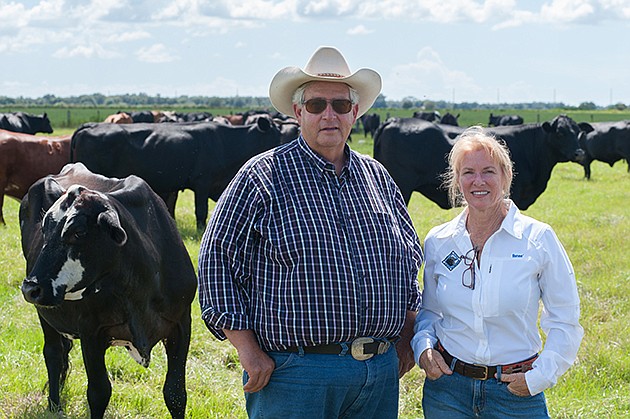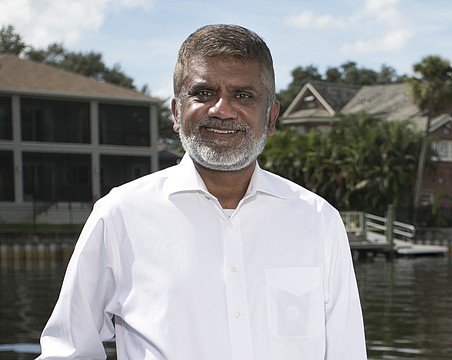Executive Summary
Company. Strickland Ranch Industry. Agriculture Key. Ranch is adding a farm-to-table segment to its business model.
Jim Strickland's promotion at his Myakka City family-run cattle and citrus farm came suddenly and tragically.
It was in 1973. Hiram Strickland, Jim's dad and onetime Manatee County tax assessor, had died unexpectedly. The multigenerational cattle-ranching family looked toward the younger Strickland, then 17, to take over. More than four decades later Jim Strickland, 60, remains at the helm of Strickland Ranch, now working in tandem with his wife, Renee Strickland.
Strickland Ranch, about 27,000 acres, has mixed survival years with periods where it thrived, much like other farms in Florida. Both Stricklands, also like many other Florida farmers, say they are in it for the passion and heritage, not necessarily sales and profits. “I'm just a cowboy,” Jim Strickland is fond of saying.
The Stricklands are also just one of a handful of cattle farms statewide to lead the way on a new, albeit risky business model: Going farm-to-table with cattle, specifically, and for now exclusively, selling high-end beef to prominent Tampa restaurateur Richard Gonzmart for use in Gonzmart's restaurants Ulele and Goody Goody.
The Gonzmart family also operates Columbia, with seven locations, but for now that side of the business doesn't get its beef from Strickland Ranch. Ulele is a high-end eatery with a Native American-inspired menu. Goody Goody is a historic Tampa brand, specializing in burgers and pies. Gonzmart and his team recently resurrected the Goody Goody concept.
“Jim is a fourth-generation rancher, his wife, Renee, is fifth generation. I'm the fourth generation co-owner and caretaker of the Columbia, and I believe family businesses provide better products because it's not just business, it's family,” says Gonzmart. “It's my personal reputation on the line, just as it is theirs.”
The risk in farm-to-table is in the process: It costs up to $1,000 extra per cattle, in feeding and monitoring, to run what's called a feeding farm, where calves travel as little as possible before ending up with the end-user. The more common way to run a cattle ranch is called the cow-calf model.
“It takes a lot more time, costs us a lot more money to do it this way,” says Jim Strickland. “We are starting to change the model. This doesn't mean Florida will turn into a feeding state. But we are trying to do something different.”
Other farmers in the state recognize the emerging trend, but so far have been slow to embrace it, says Ned Waters, president-elect of the Florida Cattlemen's Association. That's partially because of the costs involved, Waters says, but also because farm-to-table, at least with cattle, is complicated and new. Many ranch farmers are unsure of the process. “The fresh-from-Florida movement has some legs to it,” says Waters, “but it has a ways to go.”
Big business
Strickland Ranch has always been a cow-calf operation. That's a farm that produces young beef calves, usually for about six months, and then sells the lot to processing plants. The processors — Strickland works with companies from Texas to Nebraska — fatten and slaughter the cattle. Other entities take the yield and sell it to food distribution companies, grocery stores and restaurant chains.
The cow-calf model is big business in Florida. There are some 1 million head of cattle and about 15,000 beef producers statewide, according to Florida Beef Council data. The state ranks No. 9 nationwide for total cattle and calf sales, with $487 million in 2013, the council says it in its latest annual report. Calf market share leaders on the Gulf Coast include Polk County, with a 5.84% share; Hillsborough, with a 3.8% share; and Manatee, with a 2.26% share.
Strickland Ranch, about 65 miles southeast of Tampa, is one of the more active cattle sellers in the state. The Stricklands decline to disclose annual sales, only to say business has been steady of late, after a dip in cattle prices nationwide a few years ago. “We are definitely larger than most,” Renee Strickland says, “but we pale in comparison to a few huge ones in Florida.”
Growing demand
While it's not the largest cattle farm, Strickland Ranch has taken a big leadership role in adding an element of farm-to-table to its business model, in conjunction with Gonzmart. The Stricklands and Gonzmart met through mutual acquaintances in agriculture, and after several chats they realized they had an old family connection. Strickland's father worked with Gonzmart's father on a project in the 1980s.
“We have a special relationship with Mr. Gonzmart,” says Renee Strickland. “He's not only a business partner, but a friend.”
The calves for Ulele and Goody Goody, branded separately than the other calves on Strickland Ranch, remain on the farm for up to nine months. These Black Angus calves are fed differently, including Florida-grown corn and grain from Ulele's brewery. The Stricklands have been working with Gonzmart exclusively on the farm-to-table model since 2014.
After the calves leave Strickland Ranch, the process is nearly 100% made-in-Florida. There are three stops: One for more feeding and fattening; one for processing and slaughtering; and one for butchering into specifications and sizes for the restaurants.
All three places in the supply chain had been in Florida, says Jim Strickland, until one entity recently filed for bankruptcy. He's he had to get special permission from the Florida Department of Agriculture for the calves to leave Florida, for no more than 21 days, where the lot gets fed in a plant in Georgia.
Gonzmart and his team are the final stop in the supply chain. They buy the beef and store it and treat it in an aged process. Up next: the kitchen, and finally, a customer's plate. The Strickland Ranch name is even on Ulele's menu, in the section describing the origin of products used in the dishes.
“I always prefer to do business with someone I've met,” says Gonzmart. “I've been to the Strickland Ranch to see his operation. We shook hands on our deal. I have complete confidence that we're providing our guests the very best Florida beef.”
Ashley Hughes, executive director of the Florida Beef Council, says the marketing push in working with someone like Gonzmart is a big perk for Strickland Ranch.
“People want to know where their beef comes from, and there is a lot of customer demand for Florida beef,” says Hughes. “The Stricklands can now put a face to the name with what they are doing.”
The process
Better branding, says Jim Strickland, doesn't necessarily translate to higher margins in selling fresh cattle directly to an end-user such as Gonzmart. While the premiums can be higher, Strickland says he's beholden to the cattle market, and when the price of cattle is down, like it has been nationally, he drops his prices, too. “The price doesn't just go up,” says Strickland, for merely doing it this way.
The Stricklands, instead, say the work with Gonzmart has paid off in several other ways. For one, Strickland points to a reduced carbon footprint. He's not having to ship as many calves out west in trucks.
Another benefit, says Strickland, is education on a new way of farming. “This process has made us much more knowledgeable and caring farmers,” he says. “It has made us better because now we take a look at the entire life of the calf.”
Not that the Stricklands were ranch novices before working with Gonzmart.
Jim Strickland, in addition to his family history and decades in farming, has held several leadership posts with statewide beef and agriculture organizations. And Renee Strickland also has a long background in farming and cattle ranches. Her father was head rancher at what's now Babcock Ranch, a massive master-planned community under development in Charlotte and Lee counties. Renee Strickland also runs a global cattle brokerage business, where she matches farms from Pakistan to Ecuador with cattle, usually from the United States.
Together, the Stricklands have been lauded for some of their farming practices, even before working on this new model with Gonzmart. The list includes implementing a grazing system that rotates to make the pasture last longer; installing wells for cattle that protects wetlands while providing a consistent water source; and regular soil samples to make sure each pasture gets the right amount of fertilizer.
It's that kind of pride in the product that's the final motivation to keep going with Gonzmart. The Stricklands say they are unsure if they will expand the farm-to-table model to other restaurants or buyers, but they are happy to have gotten this far.
“It's nice to know your meat is as good as you thought it was,” says Jim Strickland. “That means a lot to us.”
On the ranch
Some facts about Florida cattle ranching include:
Seven of the top 10 counties for cattle and calf population growth from 2004-2013 are the Panhandle and Big Bend region.
Walton County, between Pensacola and Tallahassee, has more than doubled its herd size in the past decade.
The Florida Heartland counties in lower-central Florida — DeSoto, Glades, Hardee, Hendry, Highlands and Okeechobee — make up 31% of the entire Florida cattle population.
Source: Florida Beef Council
At a glance
Cattle on the Gulf Coast.
County Market share
Polk 5.84%
Hillsborough 3.8%
Pasco 2.29%
Manatee 2.26%
Charlotte 1.27%
Sarasota 1.02%
Lee .76%
Collier .66%
Pinellas .03%
Source: Florida Beef Council






